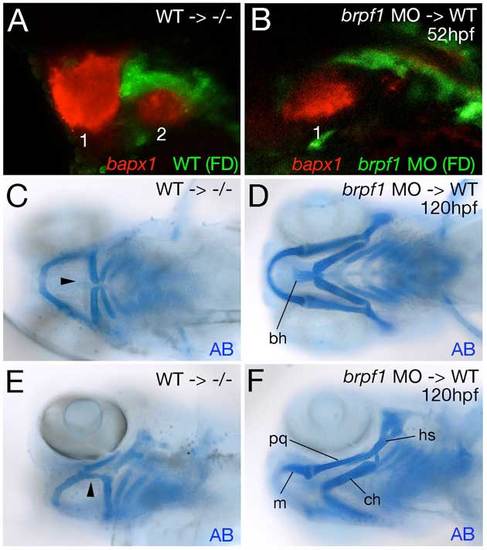Fig. S5
- ID
- ZDB-FIG-080604-34
- Publication
- Laue et al., 2008 - The multidomain protein Brpf1 binds histones and is required for Hox gene expression and segmental identity
- Other Figures
- All Figure Page
- Back to All Figure Page
|
Brpf1 in pharyngeal endoderm is neither necessary nor sufficient for segmental identities of skeletal elements of pharyngeal arches. Donor embryos were injected with Fluorescein-dextran (FD; Molecular Probes) and taramA* mRNA, encoding a constitutively active Nodal type I receptor that drives cells into an endodermal fate (David and Rosa, 2001). Upon transplantation into animal regions of host embryos, these cells directly ingress and form pharyngeal endoderm (David and Rosa, 2001), largely replacing endogenous anterior endodermal cells. (A,B) Fluorescent in situ hybridization for bapx1 transcripts (Fast Red), staining joint cells of arch 1 character, and anti-fluorescein immunostaining to visualize transplanted cells in the pharyngeal endoderm (green); 52 hpf; lateral views, confocal sections (Zeiss LSM510 META). brpf1 mutants with wild-type pharyngeal endoderm at the level of arch 2 display ectopic bapx1 expression like non-chimeric mutants (compare A with Fig. 1N; n=3/3), whereas wild-type embryos with brpf1 morphant pharyngeal endoderm lack bapx1 expression in arch 2, like non-chimeric wild-type animals (n=7/7; compare B with Fig. 1M). (C-F) Alcian Blue staining of head skeleton at 120 hpf. (C,D) Ventral views; (E,F) lateral views. Animals had been selected at 26 hpf, based on the abundance of fluorescein-positive cells in the pharyngeal endodermal cells (>50% of cells positive; not shown). Chimeric brpf1 mutants with wild-type pharyngeal endoderm show skeletal defects like non-chimeric mutants (n=4/4), including absence of basihyal (bh) (arrowhead in C; compare with Fig. 1D) and fusion of Meckel’s cartilage (m) and ceratohyal (ch) (arrowhead in E; compare with Fig. 1L). Conversely, chimeric wild types with brpf1 morphant pharyngeal endoderm are indistinguishable from non-chimeric wild-type animals (compare D with Fig. S1F, and F with Fig. 1J; n=12/12). hs, hyosymplectic; pq, palatoquadrate. |

